| |
HAART Associated with Subclinical Carotid Atherosclerosis, study finds
|
| |
| |
"Subclinical Carotid Atherosclerosis in HIV-Infected Patients Role of Combination Antiretroviral Therapy"
Stroke. March 2006;37:812
Carlos Jerico, MD; Hernando Knobel, MD; Nahum Calvo, MD; Maria L. Sorli, MD; Ana Guelar, MD; Juan L. Gimeno-Bayon, MD; Pere Saballs, MD; Jose L. Lopez-Colomes, MD Juan Pedro-Botet, MD
From the Departments of Medicine (C.J., H.K., M.L.S., A.G., J.L.G.-B., P.S., J.L.L.-C., J.P.-B.) and Radiology IDIMAS-CRC Mar (N.C.), Hospital del Mar, Barcelona, Spain; and the Universidad Autonoma de Barcelona (C.J., H.K., J.L.G.-B., P.S., J.L.L.-C., J.P.-B.), Spain.
Abstract
Background and Purpose-Whether or not combination antiretroviral therapy (CART) alone directly contributes to accelerating atherosclerosis in HIV-infected patients has not been studied in depth. This study aimed to ascertain the relationship between this therapy and subclinical carotid atherosclerosis according to cardiovascular risk.
Methods-Sixty-eight HIV-infected patients with /=2 risk factors completed the study protocol consisting of clinical, laboratory, and vascular evaluation by carotid high-resolution B-mode ultrasonography. Univariate and multivariate logistic regression analyses were performed with the presence of subclinical carotid atherosclerosis, defined by carotid intima-media thickness >0.8 mm or the presence of plaque being the dependent variable.
Results-
Among the 132 enrolled patients, 93 (70.5%) were on CART and 39 (29.5%) had never been on antiretroviral therapy. In accordance with cardiovascular risk stratification, subclinical carotid atherosclerosis was found in 26.6% (17 of 64 patients) of the very low-risk group (10-year coronary risk <5%), 35.3% (12 of 34 patients) of the low-risk group (10-year coronary risk between 5% and 9%) and 76.5% (26 of 34 patients) of the moderate/high-risk group (10-year coronary risk >/= 10%).
Conclusions-CART should be considered a strong, independent predictor for the development of subclinical atherosclerosis in HIV-infected patients, regardless of known major cardiovascular risk factors and atherogenic metabolic abnormalities induced by this therapy.
DISCUSSION
Measurement of carotid IMT with B-mode high-resolution ultrasound is a well-accepted noninvasive method of assessing atherosclerosis.15 Because carotid IMT measurements correlate satisfactorily with pathological measurements16 and are potent predictors of myocardial infarction and stroke, even after adjustment for other risk factors,17-20 carotid B-mode high-resolution ultrasound imaging has been used in several studies to evaluate cardiovascular risk in HIV-infected patients.7,8,21-27 (see references at end of report) Most but not all of these studies have in fact shown an increased prevalence of subclinical atherosclerosis in patients receiving CART. The main result of the present study was that CART exposure was the most powerful predictor of carotid atherosclerosis in HIV-infected patients after controlling for Framingham risk score. The relative contribution of CART to the accelerated atherosclerosis in HIV patients is difficult to assess from the available literature. Differences in measurement techniques, lack of statistical power in smaller studies, and the fact that not all addressed the length of CART exposure may account for the contradictory results in these reports.
Some aspects of the present study should be highlighted. First, we found that carotid IMT significantly rose as the cardiovascular risk increased, as has been demonstrated recently in a non-HIV-infected population.28 Second, from a clinical viewpoint, this is the first study to analyze the prevalence of carotid atherosclerosis in relation to the Framingham risk score in this particular clinical setting. In this regard, the prevalence of carotid atherosclerosis increased from 26.6% in the very low-risk group to 35.3% in the low-risk group and 76.5% in the moderate/high-risk group, respectively. Third, besides cardiovascular risk score, CART exposure emerged as significantly and independently associated with the presence of carotid atherosclerosis in the multivariate logistic regression analysis for all HIV-infected patients. Although time exposure to CART was not an independent factor in the logistic regression model, when CART exposure was not taken into account in this model, time exposure to CART emerged as significantly and independently associated with the presence of carotid atherosclerosis (data not shown). Finally, we separately analyzed an HIV-infected group of patients at very low cardiovascular risk (<5% at 10 years) given that they exhibit a maximum of 1 risk factor and rarely reach levels for intensive intervention. In this subset, in addition to classic cardiovascular risk factors, CART exposure was again an independent predictor of carotid atherosclerosis.
The relationship between carotid atherosclerosis and exposure to different antiretroviral drugs was not initially considered in the present study because of the limited sample size and difference in exposure times to individual drugs. Nevertheless, we wish to underline that 85% of our HIV-treated patients had been exposed to protease inhibitor-based therapy. If we had included current protease inhibitor exposure in the regression analysis, the adjusted OR would have been 13.6 (95% CI, 3.3 to 52.6; P=0.0001) for all HIV patients and 8.6 (1.3 to 55.7; P=0.02) for HIV-infected patients at very low cardiovascular risk.
Limitations of the present study are mainly related to the observational design and cross-sectional nature of the current analyses. The results reported herein are only associations from which no conclusions regarding causality can be drawn. Subclinical atherosclerosis reflects the cumulative effects of risk factors acting over many years, whereas we measured risk factors at 1 point in time only. Thus, blood lipid concentrations, blood pressure, and cardiovascular risk estimated at baseline may not accurately represent lifetime exposure. Although sociodemographic characteristics of the clinical population studied are quite similar to those of the Spanish HIV population in accordance with the National AIDS Registry,29 data on prevalence results could be generalized with caution to the overall HIV population.
In summary, these data suggest that carotid atherosclerosis in HIV-infected patients is related to conventional cardiovascular risk factors, but that CART appears to play a major role regardless of the atherogenic metabolic abnormalities induced by these drugs. Although there is general consensus that the substantial benefits of CART clearly outweigh the possible complications associated with this therapy, it must be borne in mind that with progressive aging of the HIV-infected population and the expected long-term use of CART, the need will arise to use different antiretroviral agents with potentially less cardiovascular toxicity.
Introduction
Combination antiretroviral therapy (CART) has dramatically reduced morbidity and mortality in HIV-infected patients.1 However, the potential for maintaining these patients on treatment for decades may be limited by a variety of adverse effects observed in patients on CART, including dyslipidemia, fat redistribution, insulin resistance, and premature atherosclerosis,2-4 particularly when therapy contains protease inhibitors.5-8 This fact has raised the concern that the HIV-infected population may be at increased risk for cardiovascular disease in the long term, as has been described in 2 large prospective studies.9,10
The absolute cardiovascular risk in any individual is determined by a complex interplay of several risk factors that include older age, positive family history, smoking, hypertension, elevated blood lipids, diabetes, and other determinants.11 Among the latter, the relationship between CART and atherosclerosis in HIV-infected patients remains unclear. Proatherogenic metabolic abnormalities induced by CART and chronic inflammation associated with HIV infection, together with other infectious agents, can certainly increase the cardiovascular risk in these patients. The degree to which classic cardiovascular risk factors are responsible, as opposed to HIV-related factors, is not known. In this respect, whether the antiretroviral treatment regimen itself directly contributes to accelerating atherosclerosis has not been vigorously scrutinized. Dressman et al recently showed in mice the first evidence that CART, and specifically protease inhibitors at a dosage that did not induce hyperlipidemia are potent promoters of atherosclerosis.12 To assess the role of CART as a possible cardiovascular risk factor in HIV-infected patients, we evaluated the presence of subclinical carotid atherosclerosis in these patients at different cardiovascular risk levels, with special emphasis on those at low and very low cardiovascular risk.
Thus, 55 (41.7%) of the 132 HIV-infected patients had subclinical carotid atherosclerosis, and independent variables associated with carotid
atherosclerosis (odds ratio; 95% CI) were:
--CART exposure (10.5; 2.8 to 39)
--and 10-year coronary risk 10% (4.2; 1.5 to 12).
In very low coronary risk patients (<5%), age (per 10-year increment: 4.01; 1.12 to 14.38),
--systolic blood pressure (per unit mm Hg 1.07; 1.01 to 1.14), and
--CART exposure (8.65; 1.54 to 48.54) were independently associated with subclinical carotid atherosclerosis.
Conclusions-CART should be considered a strong, independent predictor for the development of subclinical atherosclerosis in HIV-infected patients, regardless of known major cardiovascular risk factors and atherogenic metabolic abnormalities induced by this therapy.
Methods
Subjects and Study Protocol
From January to December 2003, a cross-sectional study was conducted in HIV-infected patients managed at the outpatient infectious disease unit of the Hospital del Mar, Barcelona. The first 100 HIV patients having a 0 to 1 cardiovascular risk factors were selected because, with few exceptions, subjects in this category have a low coronary risk.11 In the same period, the first 100 HIV patients with 2 cardiovascular risk factors were also recruited. Exclusion criteria included withdrawal of CART and evidence of clinical signs of active AIDS in the 3 months before entry because of their possible impact on anthropometric, blood pressure, and laboratory parameters. Furthermore, established coronary heart disease, other atherosclerotic diseases, and diabetes mellitus were the cardiovascular exclusion criteria. The protocol study approved by the local ethics committee consisted of clinical, laboratory, and vascular evaluation to assess the presence of subclinical carotid atherosclerosis in this particular clinical setting. Finally, 70 HIV-infected patients with a 0 to 1 risk factor and 62 with 2 cardiovascular risk factors agreed to participate and completed the study protocol. All participants were 20 years of age and were evaluated by trained physicians after giving their written informed consent.
Data Collection
Age, sex, HIV disease status according to the 1993 Centers for Disease Control and Prevention classification of HIV disease,13 HIV exposure (mutually exclusive in the following order: intravenous drug use, male homosexual activity, heterosexual activity), and type and duration of CART were recorded. Lipodystrophy was defined and categorized by the blinded physician (H.K.)-assessed presence of peripheral lipoatrophy (face, arms, legs, buttocks, and prominent veins), central lipohypertrophy (abdomen, breasts, dorsocervical region), and mixed lipodystrophy. Blood pressure, weight, and height were measured by standard methods.
Venous blood samples were taken in the morning after a fast of 12 hours. Total cholesterol concentration was determined using enzymatic methods in a Cobas Mira automatic analyzer (Baxter Diagnostics AG). High-density lipoprotein (HDL) cholesterol was measured using separation by precipitation with phosphotungstic acid and magnesium chloride. CD4 lymphocyte cell count and HIV RNA viral load (Nuclisens Easy Q HIV-1; Biomerieux) were performed at the time of the study; the nadir of CD4 cell count and baseline viral load levels were recorded.
Ultrasonography Measurements
Carotid high-resolution B-mode ultrasound imaging was performed to measure intima-media thickness (IMT) by a single trained investigator (N.C.) blinded to all clinical information using a Sequoia 512 ultrasound system (Acuson) with an 8L5 (5 to 8 MHz) variable frequency linear probe, depending on the anatomy of the subject.14 Carotid arteries were scanned from the lowest part visible in the supraclavicular fossa to the submandibular angle. Plaque was defined as a focal structure invading the lumen with an IMT 1.2 mm. When a plaque was identified at a predefined point, the IMT was determined in adjacent segments. The presence of subclinical carotid atherosclerosis was identified as IMT >0.8 mm, presence of plaque, or both.14
Cardiovascular Risk Assessment
Cardiovascular risk was assessed by the Framingham risk score in all HIV-infected patients according to the National Cholesterol Education Program Adult Treatment Panel III,11 even in subjects with a 0 to 1 risk factor, in whom risk assessment is not necessary. For the purpose of the present study, cardiovascular risk in HIV-infected patients was categorized as very-low (<5%, group A), low (5% to 9%, group B) and moderate/high 10-year coronary risk (10%, group C).
Statistical Analysis
Student t test was performed to assess differences between 2 means. When data were not distributed normally, Mann-Whitney U test was used. Either 2 test or Fisher exact test was used to examine the degree of association of categorical variables. Computed factors in the univariate analysis were age, sex, body mass index, HIV transmission group (dichotomized as intravenous drug users versus sexual transmission), HIV clinical stage (dichotomized as C stage versus A and B stages of CDC), current and nadir CD4 cell count, plasma HIV RNA categorized as detectable (>500 copies/mL) or undetectable, duration of CART, and type of CART classified by 2 modes: antiretroviral naive (never exposure to antiretroviral therapy), no previous protease inhibitor exposure, past or current protease inhibitor exposure; and antiretroviral naive, current non-nucleoside reverse transcriptase inhibitor-based therapy and current protease inhibitor-based therapy.
Variables demonstrating a univariate relationship (P<0.05) with the outcome variable were included in the logistic regression analysis to assess the effect of independent variables on the presence of subclinical carotid atherosclerosis. Backward stepwise logistic regression analysis was used. The variables included in the logistic regression model 1 (all patient group) were age (per 10-year increment), known duration of HIV infection in years, nadir CD4 cell count (categorized as >200/mL or 200/mL), CART classified as antiretroviral naive (reference group) and CART exposure, time in years of CART exposure, lipodystrophy categorized as absent (reference group), lipoatrophy, lipoaccumulation pattern with or without lipoatrophy, and Framingham risk score. Model 2 of the logistic regression analysis included only very low cardiovascular risk patients (<5%; patient group A), and the selected variables were the same as the previous model, whereas the Framingham risk score was excluded, and total cholesterol, current smoking status, systolic blood pressure, and gender were included. A P value <0.05 was considered statistically significant. All statistical analyses of database results were performed with the Statistical Package for the Social Sciences (SPSS for Windows; v.11.5).
RESULTS
Among the 132 enrolled patients with HIV infection, 93 (70.5%) were on CART and 39 (29.5%) naive. The latter had a younger age (37.4±8.5 years versus 45.6±9.7 years; P<0.0001) and lower total cholesterol concentration (170.2±34.8 mg/dL versus 238.3±48.8 mg/dL; P<0.0001) compared with those on CART. There were no differences in gender, smoking status, systolic blood pressure, HDL cholesterol, and body mass index between groups. According to the cardiovascular risk stratification, 64 HIV-infected patients were at very low (32 naive patients), 34 at low, and 34 at moderate/high cardiovascular risk. The main differences between the very low 10-year risk (<5%; patient group A) and other groups were predominance of younger age, female sex, naive patients and viral load >500 copies/mL, fewer current smokers, lower systolic blood pressure and total cholesterol concentration, higher HDL cholesterol concentration, and normal fat distribution (Table 1).
TABLE 1. Characteristics of the 132 HIV-Infected Patients According to the Framingham Risk Score
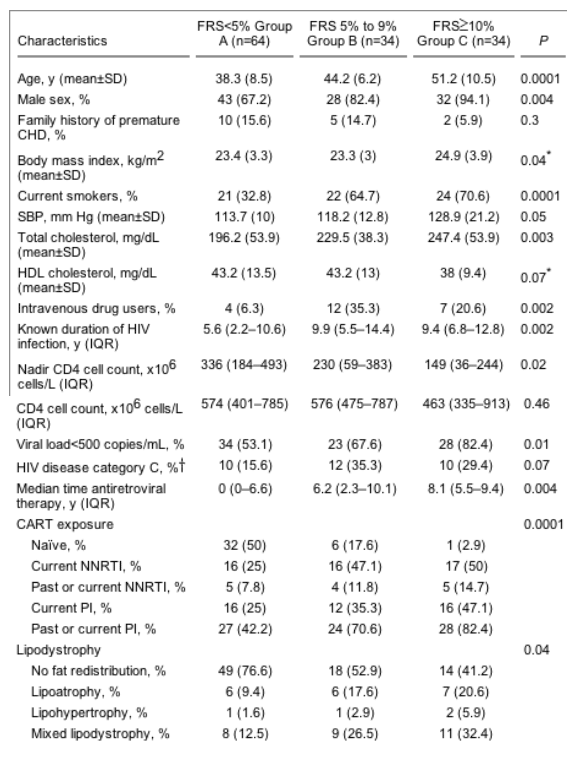
Median (interquartile range) carotid IMT in relation to the Framingham risk score was 0.54 mm (0.45 to 0.63 mm), 0.59 mm (0.5 to 0.7 mm), and 0.65 mm (0.57 to 0.75 mm) for HIV patients of group A, B, and C, respectively. Subclinical carotid atherosclerosis was found in 26.6% of the very low-risk group (17 of 64 patients), 35.3% of the low-risk group (12 of 34 patients), and 76.5% of the moderate/high-risk group (26 of 34 patients). A carotid plaque was detected in 49 (37.1%) HIV-infected patients, with 15 being from the very low-risk group (23.4%), 11 from the low-risk group (32.3%), and 23 from the moderate/high-risk group (67.6%). Thus, 55 (41.7%) of the 132 HIV-infected patients presented subclinical carotid atherosclerosis and associated factors are shown in Table 2. As expected, HIV-infected patients with subclinical carotid atherosclerosis were the oldest with a predominance of CART exposure, abnormal fat distribution, the lowest CD4 cell count and highest known duration of HIV infection and cardiovascular risk. Furthermore, in the very low cardiovascular risk HIV-infected group, only 2 of 32 (6.3%) naive patients had subclinical atherosclerosis versus 15 of 32 (46.9%) CART-exposed patients.
TABLE 2. Factors Associated With the Presence of Subclinical Carotid Atherosclerosis
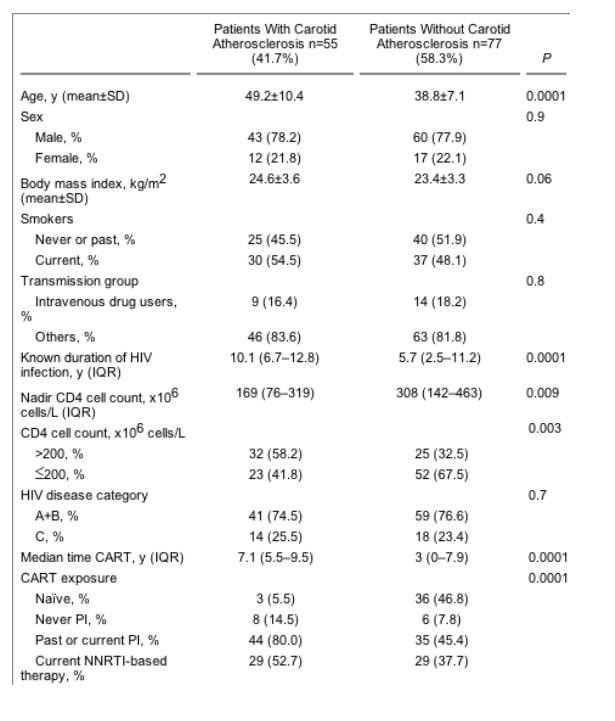
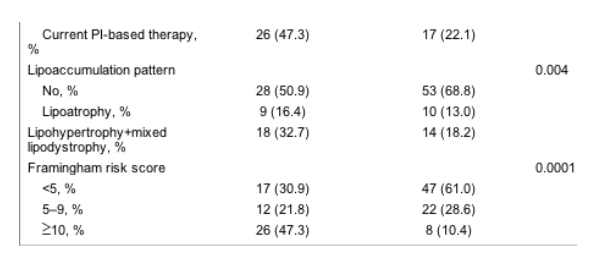
The univariate and multivariate analyses of factors associated with subclinical carotid atherosclerosis are shown in Table 3 for all patient groups and in Table 4 for patients with exclusively very low cardiovascular risk. The most significant results for all patient groups were (odds ratio [OR]; 95% CI): CART exposure (10.5; 2.8 to 39) and 10-year coronary risk 10% (4.2; 1.5 to 12) as independent variables associated with subclinical carotid atherosclerosis. In very low cardiovascular risk (<5%) patients, age (per 10-year increment: 4.01; 1.12 to 14.38), systolic blood pressure (per unit mm Hg: 1.07; 1.01 to 1.14), and CART exposure (8.65; 1.54 to 48.54) were independent predictors of subclinical carotid atherosclerosis.
TABLE 3. Univariate and Multivariate Logistic Regression Backward Conditional Analysis of Factors Associated With Subclinical Carotid Atherosclerosis in 132 HIV-Infected Patients
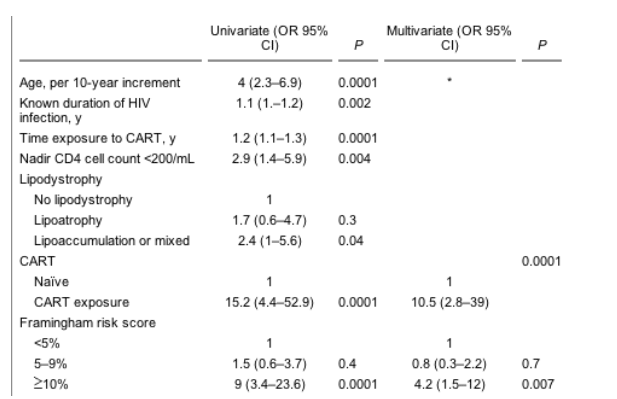
TABLE 4. Univariate and Multivariate Logistic Regression of Factors Associated With Subclinical Carotid Atherosclerosis in HIV-Infected Patients With Very Low Cardiovascular Risk (<5%)
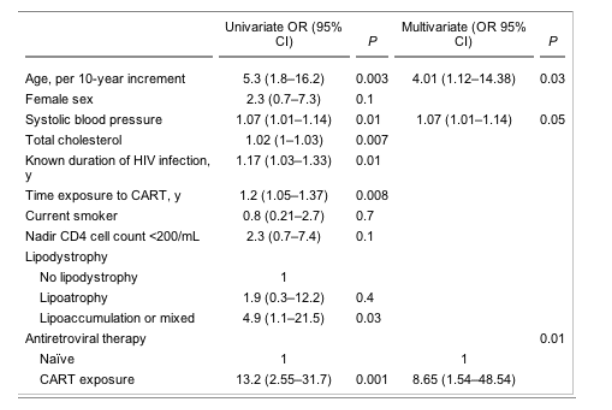
REFERENCES
7. Maggi P, Serio G, Epifani G, Fiorentino G, Saracino A, Fico C, Perilli F, Lillo A, Ferraro S, Gargiulo M, Chirianni A, Angarano G, Regina G, Pastore G. Premature lesions of the carotid vessels in HIV-1-infected patients treated with protease inhibitors. AIDS. 2000; 14: F123-F128.[CrossRef][Medline] [Order article via Infotrieve]
8. Depairon M, Chessex S, Sudre P, Rodondi N, Doser N, Chave JP, Riesen W, Nicod P, Darioli R, Telenti A, Mooser V; Swiss HIV Cohort Study. Premature atherosclerosis in HIV-infected individuals-focus on protease inhibitor therapy. AIDS. 2001; 15: 329-334.[CrossRef][Medline] [Order article via Infotrieve]
21. Seminari E, Pan A, Voltini G, Carnevale G, Maserati R, Minoli L, Meneghetti G, Tinelli C, Testa S. Assessment of atherosclerosis using carotid ultrasonography in a cohort of HIV-positive patients treated with protease inhibitors. Atherosclerosis. 2002; 162: 433-438.[CrossRef][Medline] [Order article via Infotrieve]
22. Chironi G, Escaut L, Gariepy J, Cogny A, Teicher E, Monsuez JJ, Levenson J, Simon A, Vittecoq D. Carotid intima-media thickness in heavily pretreated HIV-infected patients. J Acquired Immune Defic Syndr. 2003; 32: 490-493.[Medline] [Order article via Infotrieve]
23. Mercie P, Thiebaut R, Lavignolle V, Pellegrin JL, Yvorra-Vives MC, Morlat P, Ragnaud JM, Dupon M, Malvy D, Bellet H, Lawson-Ayayi S, Roudaut R, Dabis F. Evaluation of cardiovascular risk factors in HIV-1 infected patients using carotid intima-media thickness measurement. Ann Med. 2002; 34: 55-63.[CrossRef][Medline] [Order article via Infotrieve]
24. Hsue PY, Lo JC, Franklin A, Bolger AF, Martin JN, Deeks SG, Waters DD. Progression of atherosclerosis as assessed by carotid intima-media thickness in patients with HIV infection. Circulation. 2004; 109: 1603-1608.[Abstract/Free Full Text]
25. Maggi P, Lillo A, Perilli F, Maserati R, Chirianni A; PREVALEAT Group. Colour-Doppler ultrasonography of carotid vessels in patients treated with antiretroviral therapy: a comparative study. AIDS. 2004; 18: 1023-1028.[CrossRef][Medline] [Order article via Infotrieve]
26. Alonso-Villaverde C, Coll B, Parra S, Montero M, Calvo N, Tous M, Joven J, Masana L. Atherosclerosis in patients infected with HIV is influenced by a mutant monocyte chemoattractant protein-1 allele. Circulation. 2004; 110: 2204-2209.[Abstract/Free Full Text]
27. Currier JS, Kendall MA, Zackin R, Henry WK, Alston-Smith B, Torriani FJ, Schouten J, Mickelberg K, Li Y, Hodis HN; for the AACTG 5078 Study Team. Carotid artery intima-media thickness and HIV infection: traditional risk factors overshadow impact of protease inhibitor exposure. AIDS. 2005; 19: 927-933.[Medline] [Order article via Infotrieve]
|
|
| |
| |
|
|
|